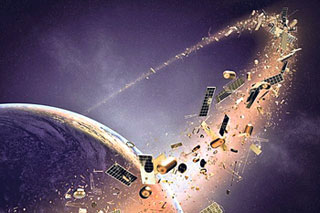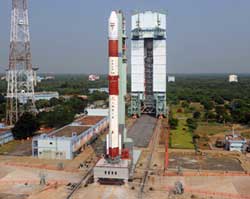December 2019 Science and Technology
Sakshi Education

- New laser-based system to spot space junk
Researchers in China have improved the accuracy of detecting space junk in the Earth's orbit,providing a more effective way to plot safe routes for spacecraft. They have developed space junk identification systems.
A unique set of algorithms for laser ranging telescopes, described in the Journal of Laser Applications, has significantly improved the success rate of space debris detection.
- NTPC to add 10GW solar capacity
NTPC is planning to add 10GW of solar energy generation capacity by 2022, which entails an investment of around Rs 50,000 crore.
At present, NTPC has installed renewable energy capacity of 920 MW, which includes mainly solar energy.
It has formulated a long term plan to become a 130 GW company by 2032 with 30 per cent non- fossil fuel or renewable energy capacity.
- CSIR and CNRS signed MoU to promote Scientific and Technological Research
 Council of Scientific & Industrial Research (CSIR) signed a Memorandum of Understanding (MoU) with the National Centre for Scientific Research (CNRS), France on 17th December 2019.
Council of Scientific & Industrial Research (CSIR) signed a Memorandum of Understanding (MoU) with the National Centre for Scientific Research (CNRS), France on 17th December 2019.
The aim of the MoU is to establish a framework for cooperation between India and France towards promotion and support of scientific and technological research.
CSIR and CNRS plan to strengthen their cooperation to foster joint innovation and transfer of technologies applicable to India or/and France and to other nations.
It aims to benefit potentially and increase synergistic cooperation possibilities for translating science into technology
The cooperation includes promoting technology transfer, sharing good practices, and enhancing industry-academia cooperation.
The research areas of mutual interest include biotechnology including plant and marine biotechnology, environment and climate change studies, engineering science and technology, energy science and technology, health research, material science and technology, and water research.
- DRDO successfully test-fired a BrahMos supersonic cruise missile
Defence Research and Development Organisation (DRDO) on test-fired a BrahMos supersonic cruise missile off the coast of Odisha successfully on 17th December 2019. The target of the missile was a ship.
The land-attack version of the missile was test-fired from a mobile autonomous launcher at Launch Complex-3 of the Integrated Test Range (ITR) at Chandipur near Balasore, Odisha.
The BrahMos missile is a medium-range ramjet supersonic cruise missile capable of being launched from submarines, ships, fighter jets or land.
BrahMos was described as the world's fastest supersonic cruise missile with a high rate of precision and accuracy. It can be fired from land, sea, and air.
BrahMos is a joint venture between the DRDO and the NPO Mashinostroyeniya (NPOM) of Russia.
The speed at which the BrahMos cruise missile travels is Mach 2.8, nearly three times that of sound.
It has the ability to strike from large stand-off ranges on any target at sea or on land with pinpoint accuracy by day or night and in all weather conditions.
- A start to be named after Indian Woman Scientist
The International Astronomical Union (IAU) has accepted to name a white-yellow star in Sextans constellation and its Jupiter-like exoplanets. Until now, the stars were called HD 86081 and 86081b.
The star will be named Bibha and the orbiting exoplanet will be named Santamasa, a Sanskrit term for clouded.
The move by IAU is aimed to bring the attention of the global countries to exoplanet research.
Bibha: Bibha Chowdhuri is a 20th-century Indian woman physicist.
- Upgraded version of Pinaka guided rocket system, QR-SAM successfully testfired
India had successfully test-fired two missiles from Chandipur in Odisha.
The upgraded version of Pinaka guided rocket system was test-fired from the DRDO’s Proof and Experimental Establishment firing test range while the all-weather tracked-chassis Quick Reaction Surface-to-Air Missile (QR-SAM) tested from a mobile launcher at a launch complex of the Integrated Test Range.
The indigenously developed Pinaka and QR-SAM weapon system test achieved the desired accuracy by hitting the intended target with a high degree of precision and met all mission objectives.
Pinaka system has a maximum range of 75 km for Mark-II variant and can fire a salvo of 12 rockets in less than 45 seconds.
QR-SAM system can also engage multiple targets within a range of around 25 to 30 km with two vehicle configurations for area air defence.
The specificity of QR-SAM missile is that it intended to defend Army formations operating in plains and semi-desert areas, including those enemy missiles that suddenly appear at close range.
The successful test of missiles will boost India to strengthen its security position.
- Ethiopia launches its first satellite
Ethiopia launched its first satellite on 20th December, 2019, a landmark achievement for the country's space program that caps a banner year for the African space industry.
The launch of the Ethiopian Remote Sensing Satellite (ETRSS) took place at a space station in China.
The live broadcast was watched by a group of Ethiopian and Chinese officials and scientists who had gathered at the Entoto Observatory and Research Centre outside the capital, Addis Ababa.
According to Temidayo Oniosun, managing director of Space in Africa, a Nigeria-based firm that tracks African space programs, this was the eighth launch of an African satellite this year, topping the previous record of seven in 2017.
The launch makes Ethiopia the eleventh African country to put a satellite into space. Egypt was the first in 1998.
Data provided by Ethiopia's satellite is expected to paint a fuller picture of the country's agriculture, forestry and mining resources and improve responses to flooding and other disasters.
- ISRO to set up third rocket launchpad
 ISRO has begun preparatory works for setting up a 3rd rocket launchpad in Kulashekhrapattinam in the Thuthukudi district of Tamil Nadu.
ISRO has begun preparatory works for setting up a 3rd rocket launchpad in Kulashekhrapattinam in the Thuthukudi district of Tamil Nadu.
At present, ISRO has two launch pads at Sriharikota in Andhra Pradesh.
The demand for additional launch pads arose as a result of the increase in the number of satellite launches from India, both for domestic and international customers.
- ISRO to set up space technology cells
ISRO announced the setting up of five space technology cells (STCs) at India’s premier engineering and science colleges.
This would be done to conduct space research, build new applications and high-end technology.
STCs have been installed at IIT- Bombay, Kanpur, Madras and Kharagpur, Bengaluru’s IISc and atthe Joint Research Programme with Savitribai Phule Pune University (SPPU).
- Duchifat-3 satellite to be launched
The “Duchifat-3”, a satellite made by Israeli students will be launched on 11 Dec 2019 from ISRO's Sriharikota launch site.
“Duchifat-3” is a satellite jointly built by Herzliya Science Center and Sha’ar Hanegev High School students of Israel.
It is the 3rd in the series of Israeli student-made satellites.
It is a photo satellite to be used for ecological research of Earth from space.
- RISAT-2BR1 to be launched today (11th December) marking 50th PSLV flight
The countdown is on for the launch of India’s radar imaging earth observation satellite RISAT-2BR1 on board PLSV-C48 from its spaceport of Sriharikota.
The workhorse Polar Satellite Launch Vehicle, on its 50th mission, PSLV-C48, is scheduled to lift off from the first launch pad of the Satish Dhawan Space Centre at Sriharikota, about 130 km from here at 3.25 p.m. on December 11.
Wednesday’s launch will mark a significant milestone for the space agency as it would be the 50th flight of the PSLV and also the 75th vehicle mission from Sriharikota.
- Worlds first fully electric commercial aircraft successfully tested in Canada
The Australian company, Harbour Air and magniX flight-tested an all-electric powered seaplane.
It has taken flight in Vancouver, Canada. The company aims to electrify its entire fleet by 2022.
It was described as the world's first for the aviation industry.
The test involved a six-passenger DHC-2 de Havilland Beaver with a 750-horsepower (560 kW) magni500 propulsion system.
The invention is aimed to boost the electric which will help to reduce the carbon emissions in the high-polluting aviation sector.
The aim to provide a clean and efficient way to power airplanes.
The new technology will mean significant cost savings and zero emissions for airlines.
- North Korea conducts another crucial test at Sohae launch site
North Korea conducted another crucial test at its Sohae satellite launch site.
The research successes will be applied to further bolstering up the reliable strategic nuclear deterrent of the country.
Nuclear negotiations between Pyongyang and Washington remain deadlocked with a deadline approaching.
- India to Host 36th Geological Congress
India will host the 36th International Geological Congress (IGC) in the Delhi in March, 2020.
The theme of the forthcoming conference is ‘Geosciences: The Basic Science for a Sustainable Development’.
The IGCs are a prestigious global geoscientific events held once in four years and participated by around 5000-6000 geoscientists from all over the world.
- NASA select site Nightingale for observation
NASA has finally selected a sample collection site on asteroid Bennu after the arrival of OSIRIS-REx spacecraft in December 2018.
The OSIRIS-Rex mission team has selected the site designated Nightingale, which is located in a crater high in Bennu's northern hemisphere. The team has also selected site Osprey of Bennu as a backup sample collection site.
OSIRIS-REx spacecraft mapped the entire asteroid in order to identify the safest and most accessible spots for the spacecraft to collect a sample so far.
Site Nightingale is located in a northern crater 460 feet wide of the asteroid.
As the site is located so far north, the temperatures in the region are lower than elsewhere on the asteroid and the surface material is well-preserved.
OSIRIS-REx sample collection has been scheduled for the latter half of 2020.
The spacecraft is expected to return the asteroid samples to Earth on 24 September 2023.
- ISRO to launch RISAT 2BR1 on 11 December
ISRO has planned to launch sharp-eyed surveillance satellite RISAT-2BR1 (Radar Imaging Satellite-2) with Synthetic Aperture Radar (SAR) on 11 December 2019.
RISAT-2BR1:- RISAT-2BR1 is a radar imaging satellite.
- It is dubbed as a spy satellite.
- It can take pictures of the earth during day and night even under cloudy conditions.
- The satellites will help 24/7 border surveillance along with checking infiltration.
- It will keep an eye on terror or anti-national activities across the borders.
- ISRO also plans to launch radar imaging satellite 2BR2 with synthetic aperture radar after the launch.
- India successfully test fired Prithvi II missile
India successfully conducted a night test-trial of the indigenously developed nuclear-capable surface-to-surface Prithvi-II missile off complex-3 of Integrated Test Range in Chandipur, Odisha coast.
The test of the short-range ballistic missile was conducted by the Strategic Forces Command.
Prithvi-II missile:- The surface-to-surface Prithvi-II missile has a strike range of 350 km.
- It is capable of carrying 500 to 1,000 kg of warheads. It is powered by liquid propulsion twin engines.
- The missile was inducted into the Indian defence forces in 2003.
- The missile was developed by Defence Research and Development Organization (DRDO) under the Integrated Guided Missile Development Programme (IGMDP) of the Ministry of Defence.
- Punjab partnered with WEF to promote electric mobility
Punjab State government partnered with the World Economic Forum (WEF) to design a Public-Private pilot on shared, clean and electric mobility.
The move aims to combat the growing problem of environmental pollution in the state.
WEF Partnership:- The state is preparing its own EV policy to support the adoption of e-vehicles.
- WEF chose Punjab, as it is well-positioned for shared EV transition.
- WEF has already housed an existing auto component manufacturing base, besides having skilled labour and being a power surplus.
- The public-Private pilot will examine how Public and Private sectors can interplay to offer the most robust and successful EV ecosystem. It is a part of the collaboration to be formulated at the WEF annual meeting in Davos in January 2020.
Published date : 27 Dec 2019 06:11PM



















